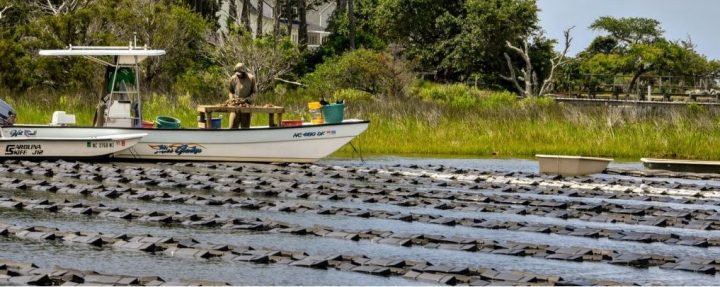
RALEIGH – The North Carolina Coastal Federation is taking the next steps toward realizing its vision to make the state “the Napa Valley of Oysters” with its 2019 North Carolina Oyster Summit in March.
The limited-seat summit focusing on the future of oysters in the state is from 9 a.m. to 5 p.m. March 12 at the North Carolina Museum of Natural Sciences. A legislative reception will follow 5:30-7:30 p.m. at Transfer Co. Food Hall featuring North Carolina oysters and local craft brews.
Supporter Spotlight
The daylong oyster summit is geared toward elected officials, fishers, educators, scientists, resource managers, shellfish growers, those involved in establishing public policy and oysters growers and researchers, according to the federation.

“The focus of the summit is to reflect on the progress made on oyster rehabilitation efforts, the growing mariculture industry and highlight the opportunities for continued success,” said Erin Fleckenstein, coastal scientist with the federation. She added that she hopes attendees see that there has been a great deal of progress and that the state is a national leader in oyster restoration efforts and a growing player regarding oyster farming.
Early-bird tickets for the summit can be purchased for $95 through Monday, Feb. 18. From Feb. 18 to March 5, registration for the summit is $125. Tickets for the legislative reception are $50. All tickets are available online.
“The summit brings together the broad diversity of people who support the rebirth of oysters along our coast,” said Todd Miller, the federation’s executive director. “It will help to show how clean water, thriving oysters and good jobs all go hand-in-hand.”

North Carolina Department of Environmental Quality Secretary Michael Regan will give opening remarks the summit. Regan announced in 2018 the state’s participation in the National Oceanic and Atmospheric Administration’s National Shellfish Initiative.
Supporter Spotlight
North Carolina is the first state in the Southeast, joining Washington, Connecticut, Alaska and Rhode Island, in modeling a program based on NOAA’s National Shellfish Initiative. The state initiative is a partnership with the federation, North Carolina Division of Marine Fisheries and North Carolina Sea Grant.
During the summit, the status of the North Carolina Oyster Blueprint and North Carolina Shellfish Initiative are to be presented and discussions are planned on oyster rehabilitation work, wild stock enhancement and the importance of water quality protection and restoration.
Also on the agenda are a series of panel presentations exploring the recommendations of the recently completed North Carolina Strategic Plan For Shellfish Mariculture: A Vision To 2030 that was submitted to the General Assembly Dec. 30, 2018.
“The mariculture plan has the potential to provide more than a 1,000 new jobs to coastal residents in a way that will benefit our coastal environment and economy,” said Miller.
The 177-page report was created at the behest of the General Assembly and “presents a strategic vision for a decade (to 2030) of sustainable growth of the shellfish mariculture industry,” according to the report.
In 2016, the North Carolina Policy Collaboratory was directed by the General Assembly to organize stakeholder meetings aimed at boosting the state’s shellfish industry. The Senate in 2017 added a mandate to the legislation that the legislature-established collaboratory at the University of North Carolina Chapel Hill prepare a shellfish mariculture plan by Dec. 31, 2018.
The collaboratory, which facilitates and funds research related to environmental and economic components of the management of natural resources, then formed the Shellfish Mariculture Advisory Committee to produce the report of findings and recommendations “that would promote the growth of a socially, ecologically, and economically responsible shellfish mariculture industry,” the report states.
Committee meetings began in early 2017 to discuss ways to support the state “shellfish industry, identify barriers to industry growth, and generate recommendations aimed at overcoming natural, business, and management challenges,” per the report.
The Shellfish Mariculture Advisory Committee’s “overarching goal has been to leverage a broad base of expertise to generate a comprehensive plan to grow the industry while balancing the needs of diverse North Carolina stakeholders to whom coastal public trust waters belong,” the report states.
Referring to strategic plans used by other states and counties for shellfish mariculture and based on input from members in the group that represented academia, regulatory agencies, non-governmental organizations and industry stakeholders, the committee identified in the report five major areas of concentration requiring legislative action: key business metrics and climate; industry governance and leadership/promotion; siting shellfish mariculture; water quality; and applied research and development.
Included in the report 21 major and four supplementary recommendations are to help the General Assembly determine legislative actions to encourage responsible growth of shellfish mariculture.

Ana Zivanovic-Nenadovic, senior policy analyst for the federation, who was on the advisory committee, explained that “The estuarine waters of North Carolina are underutilized when compared to waters of other states with similar biological productivity. I think the combination of the potential of our waters, and the realization of the economic benefit mariculture would bring, along with the increased interest — higher number of lease and permit applications — led to the strategic plan funding.”
The mariculture strategic plan will have multiple benefits to the coastal area and the state, she continued. “The first thing that comes to mind are ecosystem services. As filter feeders, oysters contribute to better water quality. They also provide healthy and sustainably raised food,” she said.
“The mariculture plans will also bring important economic benefits to the state and the coastal region. The plan’s stated plan is to bring in $100 million in 10 years and is estimated to support more than 1,000 jobs,” Zivanovic-Nenadovic said. “The plan also lays out efficient governance and promotion structures for the mariculture industry that will put North Carolina in a competitive position.”
Now that the plan has been submitted to the General Assembly, “The immediate next steps are to work on bill drafting to implement the plan recommendations and secure appropriations through the General Assembly,” said Zivanovic-Nenadovic.
The Coastal Federation and partners, North Carolina Sea Grant, National Oceanic and Atmospheric Administration, North Carolina Department of Environmental Quality, and the North Carolina Division of Marine Fisheries, are hosting the March summit.
A block of rooms has been reserved until Monday, Feb. 18, through the federation at Holiday Inn Raleigh Downtown Capital at a rate of $124 per night for single and double rooms, including parking.
For more information about the summit, contact Fleckenstein at erinf@nccoast.org or 252-473-1607.
The summit is sponsored in part by Albemarle Pamlico National Estuary Partnership, Grady White Boats, the Kenan Institute, Restoration Systems, Rob Lamme & Associates, The Nature Conservancy, North Carolina Sea Grant, Fred Adams Paving, Backwater Environmental and Little Environments, PLLC.
To help sponsor the summit, contact Catherine Snead at catherines@nccoast.org.







